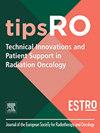Clinical validation of using a commercial synthetic-computed tomography solution for brain MRI-only radiotherapy treatment planning
IF 2.8
Q1 Nursing
Technical Innovations and Patient Support in Radiation Oncology
Pub Date : 2025-08-20
DOI:10.1016/j.tipsro.2025.100328
引用次数: 0
Abstract
Background and purpose
MRI-only radiotherapy treatment planning (RTP) relies on synthetic-CT (sCT) images for dose calculation. This study evaluates the clinical feasibility of using a commercial sCT solution in brain RTP, MRCAT Brain, focusing on dosimetric accuracy and patient setup verification.
Method and materials
For dosimetric evaluation, 93 patients with brain cancer who were treated with volumetric modulated arc therapy (VMAT) using a CT/MRI fusion workflow were included. sCT images were generated using MRCAT Brain. The sCT images were rigidly co-registered to the CT images. The clinical plan produced on the CT was recalculated on the sCT. Dosimetric accuracy was assessed by comparing dose differences in dose volume histogram (DVH) statistics for the planning target volume (PTV) and organs at risk (OARs).
For patient setup verification, 70 patients were included, and total of 572 cone beam CT (CBCT) registrations were performed with sCT and CT as reference images. The sCT matching accuracy was validated by comparing the translational and rotational differences between sCT-CBCT and CT-CBCT registrations.
Results
The PTV mean dose difference between CT and sCT were 0.3 %, 0.4 %, and 0.2 % for D50%, D2%, and D98%, respectively. The OAR mean dose differences were less than 0.3 % for all OARs. 4 of 93 patients (4.3 %) showed gross dosimetric errors of greater than ± 2 %. 3/4 were caused by sCT error. For positioning verification, all results were between ± 1 mm and ± 1°.
Conclusion
This study demonstrates the clinical feasibility of the MRCAT solution for brain MRI-only RTP, with dosimetric differences being clinically acceptable, along with submillimetre and sub-degree accuracy in patient setup verification.
使用商用合成计算机断层扫描解决方案进行脑核磁共振放射治疗计划的临床验证
背景与目的磁共振放射治疗计划(RTP)依赖于合成ct (sCT)图像进行剂量计算。本研究评估了商用sCT溶液在脑RTP、MRCAT脑中应用的临床可行性,重点关注剂量学准确性和患者设置验证。方法和材料为进行剂量学评估,纳入了93例采用CT/MRI融合工作流程进行体积调制电弧治疗(VMAT)的脑癌患者。sCT图像生成使用MRCAT脑。sCT图像与CT图像严格共配准。CT上生成的临床计划在sCT上重新计算。通过比较计划靶体积(PTV)和危险器官(OARs)的剂量体积直方图(DVH)统计数据的剂量差异来评估剂量学的准确性。为了验证患者设置,纳入了70例患者,并以sCT和CT作为参考图像进行了总共572例锥形束CT (CBCT)配准。通过比较sCT- cbct和CT-CBCT配准之间的平移和旋转差异来验证sCT匹配的准确性。结果D50%、D2%和D98%时,CT与sCT的PTV平均剂量差分别为0.3%、0.4%和0.2%。所有桨的平均剂量差异小于0.3%。93例患者中4例(4.3%)的总剂量学误差大于±2%。3/4是由sCT错误引起的。定位验证结果均在±1 mm ~±1°之间。本研究证明了MRCAT溶液用于脑mri RTP的临床可行性,剂量学差异在临床上是可接受的,并且在患者设置验证中具有亚毫米和亚度的准确性。
本文章由计算机程序翻译,如有差异,请以英文原文为准。
求助全文
约1分钟内获得全文
求助全文
来源期刊

Technical Innovations and Patient Support in Radiation Oncology
Nursing-Oncology (nursing)
CiteScore
4.10
自引率
0.00%
发文量
48
审稿时长
67 days
 求助内容:
求助内容: 应助结果提醒方式:
应助结果提醒方式:


